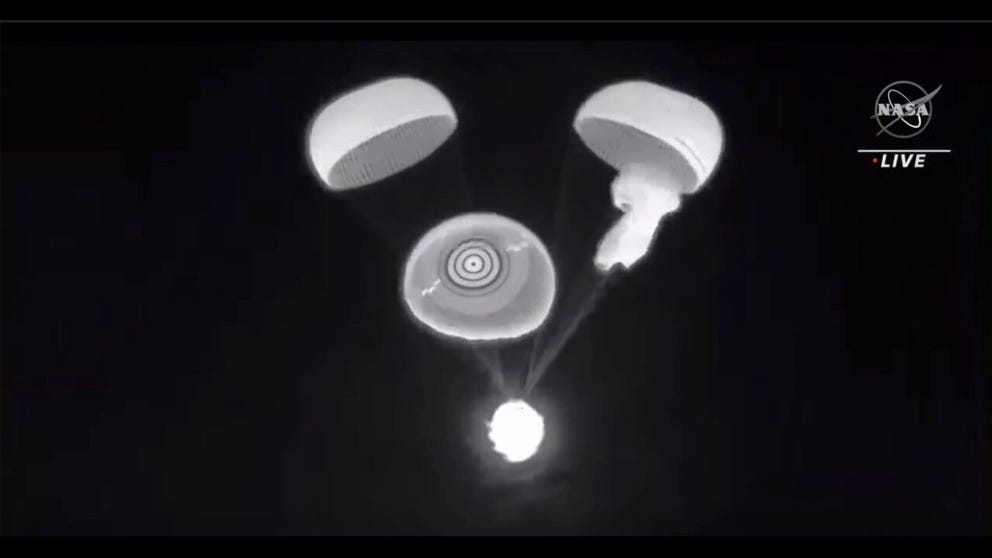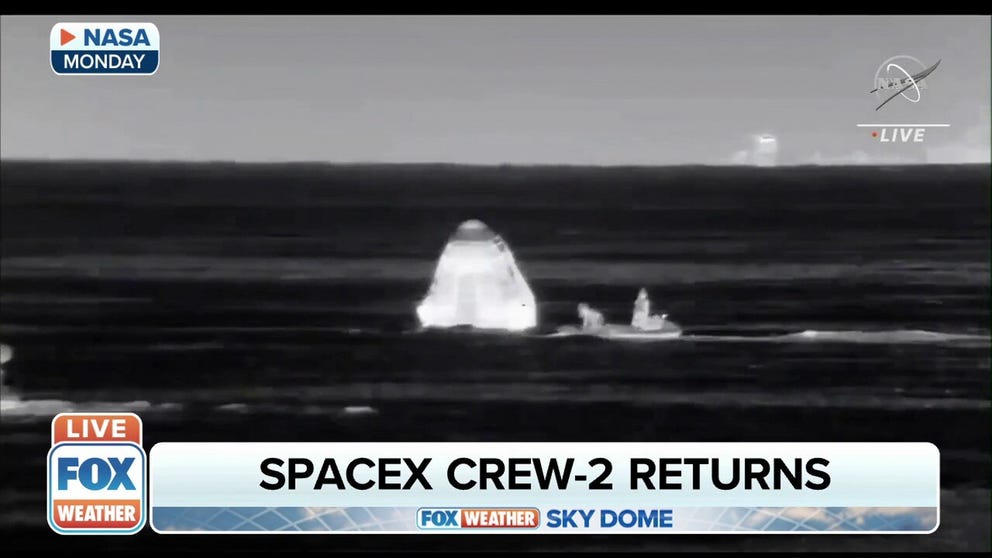NASA reviewing parachute deploy after Crew-2 astronaut splashdown
NASA's head of human spaceflight said teams will try to understand why one Dragon main parachute was lagging.
One of Dragon Endeavour's main parachutes takes longer to deploy
SpaceX safely landed the Crew-2 astronauts off Florida's coast with the help of a parachute system. One of those chutes took a little longer to deploy.
When SpaceX's Dragon spacecraft returns astronauts to Earth, the capsule uses a parachute system to slow down, ending in a soft splashdown. During the Crew-2 landing Monday night, one of the spacecraft's four main parachutes took a little longer to open than the other three.
NASA officials said they would review how the chutes were packed to determine if any steps needed to be taken.
As Dragon screeches through Earth's atmosphere, it deploys two drogue chutes while it's moving at 350 mph at about 18,000 feet up, then at about 6,500 feet, the four main chutes deploy, slowing the spacecraft from about 119 mph to 15 mph.
NASA's head of human spaceflight Kathy Lueders addressed the one main chute delay in her remarks after Monday night's splashdown.
"I know folks will be wondering about that one lagging main parachute, and the team will be going off and looking at how the loading was on the chutes and understanding that behavior," she said. "It is behavior we've seen multiple times in other tests, and it usually happens when the lines kind of bunched up together until the aero forces kind of open up and spread the chutes."
SpaceX conducted dozens of tests with its two-stage parachute system before it launched astronauts for the first time. The 27th and final test of the Mark 3 parachutes happened in 2020 before SpaceX launched NASA astronauts Bob Behnken and Doug Hurley on the Demo-2 test flight to the International Space Station.
On Tuesday during a flight readiness review for the Crew-3 launch, the parachute data was thoroughly reviewed by both NASA and SpaceX.
SpaceX vice president of Build and Flight Reliability William Gerstenmaier said this is a known condition that can occur with the four main parachutes.
"This one was a little bit slow deployed, about 75 seconds late. But again, all within the design criteria," Gerstenmaier said, adding that the parachutes were flown back to Cape Canaveral and examined in a hangar by SpaceX and NASA teams. SpaceX also spoke with the parachute manufacturer.
In the live stream of the landing Monday night, the fourth main parachute took a few more seconds to open while the other three inflated. NASA and SpaceX commentators moderating the event remarked on the delayed chute but said mission managers confirmed "four healthy mains."
The descent rate of the spacecraft was standard, and splashdown happened right on time at 10:33 p.m. ET.
SpaceX Crew-2 return to Earth, Crew-3 set to launch Wednesday night
NASA's SpaceX Crew-2 returned to Earth, splashing down off the coast of Pensacola, Florida Monday night. While Crew-3 is still set to launch Wednesday night around 9 p.m.
"The one thing that makes me feel more confident is that the loading and the deceleration of the spacecraft were all nominal for us, which is good news," Lueders said.
NASA astronauts Shane Kimbrough and Megan McArthur, Japan Aerospace Exploration Agency astronaut Akihiko Hoshide, and European Space Agency astronaut Thomas Pesquet were out of their spacecraft about an hour post-splashdown.
The Crew-2 mission astronauts completed 199 days in space after launching in Dragon Endeavour in April.
NASA and SpaceX will conduct a flight readiness review Tuesday evening ahead of the next astronaut launch from Kennedy Space Center, known as Crew-3. The parachutes will likely be a topic of discussion for mission managers.

